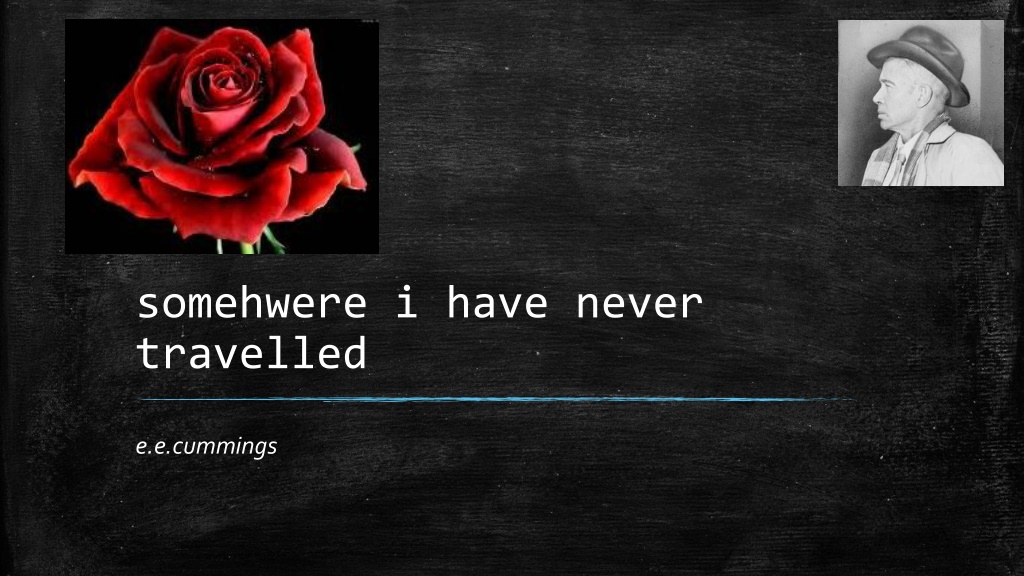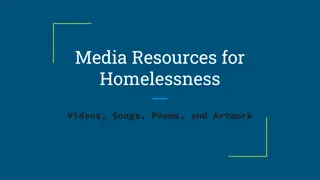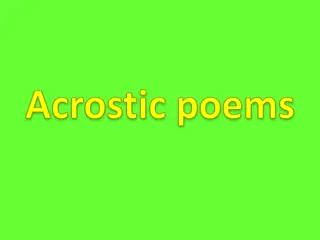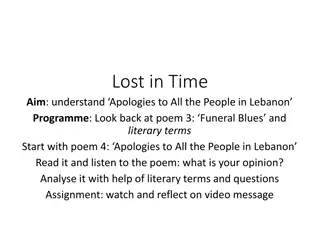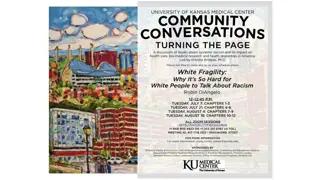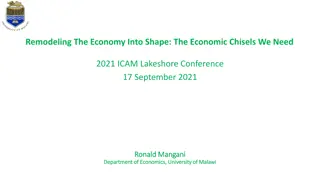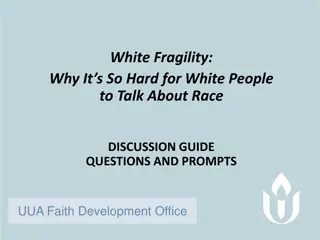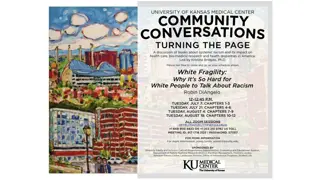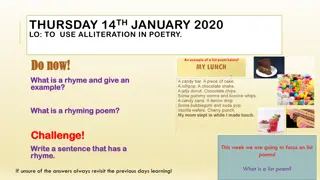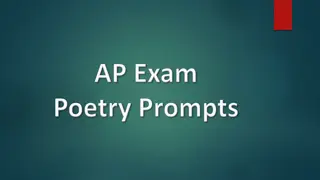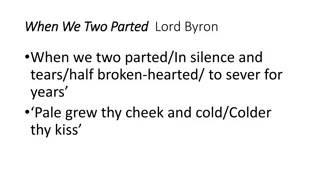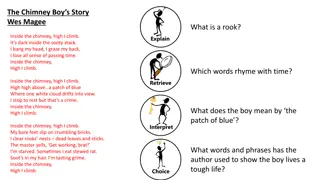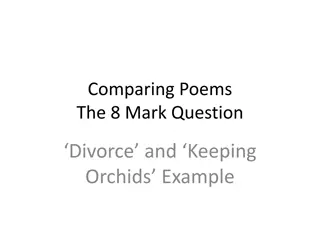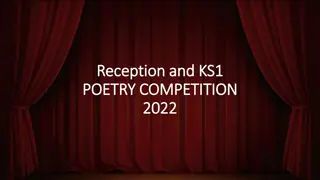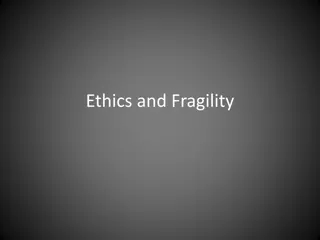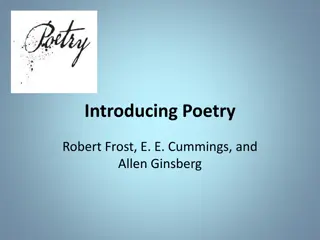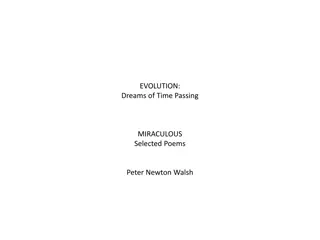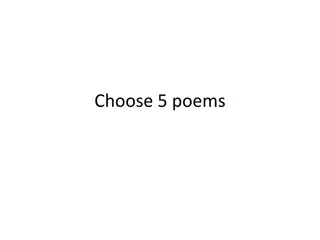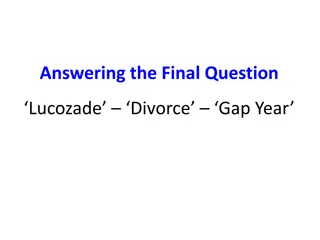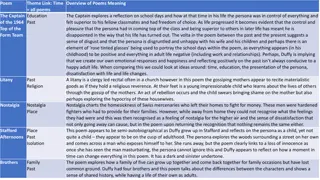Exploring Love and Fragility: Poems by e.e. cummings
Love, as portrayed in e.e. cummings' poems, is a complex journey of emotional extremes, highs and lows intertwined in a beautiful tapestry of human experience. The poet delves into the intricacies of love, capturing its essence in the most profound yet conflicting emotions. Through his verses, cummings eloquently expresses the power of love to touch the soul, revealing its intensity and fragility in captivating ways that resonate deeply with the reader.
Download Presentation

Please find below an Image/Link to download the presentation.
The content on the website is provided AS IS for your information and personal use only. It may not be sold, licensed, or shared on other websites without obtaining consent from the author. Download presentation by click this link. If you encounter any issues during the download, it is possible that the publisher has removed the file from their server.
E N D
Presentation Transcript
somehwere i have never travelled e.e.cummings
somehwere i have never travelled, gladly beyond any experience, your eyes have their silence: in your most frail gesture are things which enclose me, or which i cannot touch because they are too near your slightest look easily will unclose me though i have closed myself as fingers, you open always petal by petal myself as Spring opens (touching skilfully, mysteriously) her first rose or if your wish be to close me, i and my life will shut very beautifully, suddenly, as when the heart of this flower imagines the snow carefully everywhere descending;
nothing which we are to perceive in this world equals the power of your intense fragility: whose texture compels me with the colour of its countries, rendering death and forever with each breathing (i do not know what it is about you that closes and opens; only something in me understands the voice of your eyes is deeper than all roses) nobody, not even the rain, has such small hands
e.e.cummings Edward Estlin Cummings was born in Cambridge, Massachusetts, on October 14, 1894. He began writing poems as early as 1904 and studied Latin and Greek at the Cambridge Latin High School. In 1917, Cummings published an early selection of poems in the anthology Eight Harvard poets. At the time of his death, September 3, 1962, he was the second most widely read poet in the United States, after Robert Frost. He is buried in Forest Hills Cemetery in Boston, Massachusetts.
Summary: Love is complicated. It brings out extremes of emotional highs and lows. In this poem the poet takes all the extremes of love into account and somehow finds the beauty in them. Both the highs and the lows are part of the appeal for the speaker. This poem manages to capture the un-capturable way that there's beauty in both extremes that are part of being in love. The poem is about a man who is desperately in love. He starts off by stating that he is embarking on a fabulous journey deep into his lover's mysterious eyes.
Summary: He describes how she has amazing powers over him. She can controls him emotionally with the flick of her hand or the smallest of glances. Whatever she does is amazing to him. The speaker takes it even farther when he compares himself to a rose being opened and closed by the seasons. He even goes so far as to say that his lover can open to the infinite: the universe, death, and whatever comes after. In the end, he admits that he has no idea what gives her so much power over him. He's obsessed.
Imagery: Imagery seems to be everywhere in the poem and nowhere in particular. It is often considered along with other commonly used terminology (figurative language; symbol, metaphor, etc), the boundaries being fuzzy. It is when figurative language (like metaphororsimile) provides a picture that evokes any of the senses, that is imagery. Imagery may be defined as the representation through language of sense experience. Poetry appeals directly to our senses, of course, through its music and rhythm, which we actually hear when it is read aloud. (Perrine, Sound and Sense, 1988:54)
Visual Imagery Silence and gesture (stanza 1, line 1-4) In the first stanza, silence is a visual imagery because it needs the sense of sight to notice silence. It tells that cummings found silence by looking at his lover s eyes. The word gesture also considered as a visual imagery because it is caught by sense of sight. He sees the gesture which enclose him.
Visual Imagery: lookand open(stanza 2, line 5-8) The writer wants to tell the readers about the gaze of his lover by using the visual imagery. The visual imagery can be seen in the second stanza from the word look . We can see that someone has a slightest look by looking at his eyes. Another visual imagery is the word open . The writer sees that his lover opened himself one by one.
Visual Imagery: colour (stanza 4, line 15-16) The word colour is considered as a visual imagery because we have to see which colour that some thing had. In this stanza, the writer has some memorable impression of the certain colour of the countries.
Visual Imagery: Closes, opens and voice(stanza 4, line 17-20) There are several visual imageries in the fourthstanza above; they are closes , opens , and voice . The words closes and opens describe what the writer sees about his lover. Only something in him understands what closes and opens mean. The visual imagery can also be seen from the word voice . It is also considered as a visual imagery because voice, in the last stanza above, means some sounds that the eyes can tell.
Figurative Language: Simile: your slightest look easily will unclose me though i have closed myself as fingers, you open always petal by petal myself as Spring opens (touching skilfully, mysteriously) her first rose In the second stanza, the writer compares himself with fingers. He closes himself like a folded finger, but in the next line he comparing his lover with a spring. She always open himself side by side like a spring opens her first rose. This stanza explains that the writer s lover always understand him no matter what.
Figurative Language: Or if your wish be to close me, I and My life will shut very beautifully, suddenly, As when the heart of this flower imagines The snow carefully everywhere descending; (stanza 3, line 9-12) The writer compares himself with the heart of the flower in the third stanza. This stanza describes the imagination of the writer when his lover s wish is to let him down, it will be like snow which descending carefully everywhere.
Symbols: Eyes Somewhere I have never travelled, gladly beyond any experiences, your eyes have their silence: (stanza 1, line 1-2) An interpretation could mean that unexplored place the speaker is heading into the depths of his lover s eyes. Making them seen more mysterious and un-knownable. All eyes must be silent, they can not talk at all. There is, however, a way they can. The eyes are window to the soul you can look down into a person s eyes and see what they re feeling and thinking.
Symbol Roses (touching skillfully, mysteriously) her first rose (stanza 2, line 7-8 ) The already obvious love symbolism is taken into to an erotic place with all this talk of spring touching skillfully, mysteriously. Generally according to popular perception, we relate women to flowers. So it can be assumed that speaker in this poem is a male. So her first rose can interpreted that someone who had her first love.
Symbol Power somewhere I have never travelled is the first line of this poem. It indicates that the speaker of this poem tries to bring the reader into somewhere that he has taken or will take. Though the destinations of his journey are unrevealed, the speaker probably know that it is a journey toward the happiness as it said in next line gladly beyond any experiences . There is an undercurrent of powerlessness.
Conclusion ee cummings s somewhere i have never travelled is one of poems which describe the life of love in pretty-male dominating in 1930 s. From the analysis, it can be concluded that the speaker in this poem is very introspective. It casts a different perspective on how to love someone with all sincerity in different way. Love is not a logical construct it is based on her/his psyche/ emotions. In this poem cumming s describes a condition of someone who loves and the deep mysteriousness of her love. He does not quite know who she is, and it is the mystery that keeps him hooked . However, most of critics the poem assume that it is a male describing himself in typically feminine terms, and all the things that he want to do for her only seems to make her love him more.
Questions: 1. Give examples of how cumming s uses syntax to enhance perspective in somewhere i have never travelled, gladly beyond . (3) 2. Identify three metaphors/ similes are used throughout the poem "somewhere I have never travelled, gladly beyond," and what are they comparing? Are the images presented in these metaphors/ similes typical for a love poem? (6) 3. What is the meaning of nobody, not even the rain, has such small hands in "somewhere I have never travelled"? (3)
Questions: 4. What is poem about? (3) 5. What is the theme of the poem? Justify your answer. (3) 6. Using this poem, how would you describe cummings' views on modern society? (2) 7. How does this give a different perspective on love?
